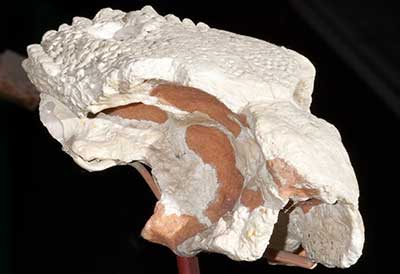Homalocephale
(home-ah-loh-SEFF-ah-lee)
| Quick Facts | |
|---|---|
| Name Meaning: | Even Head |
| Distribution: | Mongolia |
| Time Period: | Late Cretaceous, 80 Ma |
| Length: | 3+ ft (1 m) |
| Linnaean Classification | |
| Kingdom: | Animalia |
| Phylum: | Chordata |
| Class: | Reptilia |
| Superorder: | Dinosauria |
| Order: | Ornithischia |
| Infraorder: | Pachycephalosauria |
| Family: | Homalocephalidae |
| Genus: | Homalocephale |
| Cladistic Classification | |
| |

History
The Homalocephale was first described in 1974 by Maryanska and Osmolska. It was discovered in Mongolia and is currently the only genus of the species. It was described from an incomplete skull and post cranial material. Recently in 2009 and 2010, paleontologists conducted several studies and determined that the Homalocephale may be a juvenile version of another dinosaur, possibly the Prenocephale, but these claims are difficult to prove.Description
The Homalocephale was relatively small in size, about the size of a large dog. It had short canine-like teeth and large eye sockets. The most distinguishing feature of the Homalocephale, like other Pachycephalosaurs, was its thick bone head. This cranial dome was not as well developed like that of other pachycephalosaurs like the Pachycephalosaurus. The head, however, was flatter than most. It may have been used to head butt others of its genus in competition. Another feature is the discovery of unusually wide hips leading some paleontologists to believe that the dinosaur gave birth to live young, unlike many dinosaurs that lay eggs.
ScienceViews Writer: Jason Hamilton.
Copyright © 2005-2010 Calvin & Rosanna Hamilton. All rights reserved.